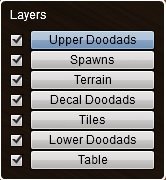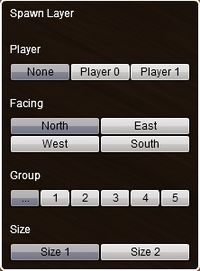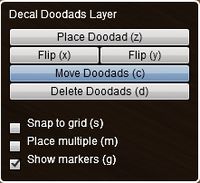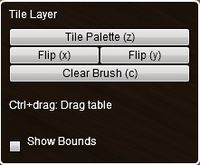This guide presents the user interface of the Custom Board Editor. Custom scenarios are a feature of the Card Hunter game universe. Players are given free rein to design custom game boards with the board editor and setup scenarios to enjoy stress free tabletop-like games with friends or other players. You can play with your own multiplayer party or take on the role of monsters. Make escort missions or King of the Hill battle scenarios. Decimate countless mob waves or survive single character challenges. As of writing, custom scenarios support only single player vs AI and single player vs single player custom games. Readers are advised to browse A Tutorial to making custom scenarios as a prelude.
Custom Board Editor Screenshot
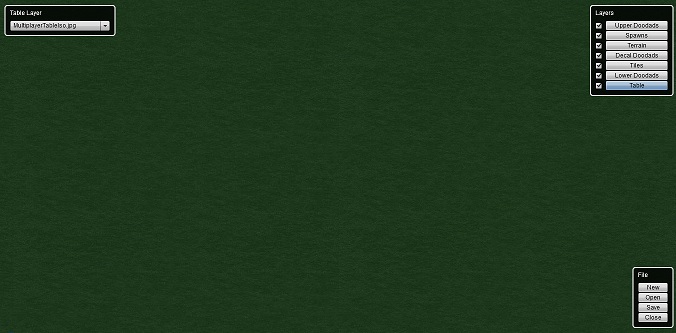
Custom Board Editor User Interface
File Menu
- New: discard current board.
- Open: load board file (.brd).
- Save: save current board.
- Close: discard changes and return to Multiplayer lobby (not the scenario editor).
|
|
|
Layers Menu
- Board details are saved in 7 layers, drawn from the bottom up. This menu has check boxes to select which ones are visible while you're editing (when playing a board, only the bottom four are visible) and buttons to select which layer you want to edit.
|
|
Upper Doodads Layer Menu
- Set where the dead chars go. If you don't set any, they just fly off the table.
- Place Doodad: opens marker palette for selection
- Flip: flips the orientation of the upper doodad
- Move Doodads: moves doodads, duh !
- Delete Doodads: deletes doodads, duh !
- Snap to grid: doodads placed snaps to grid. Avoids overlapping doodads.
- Place multiple: places multiple doodads at once.
- Show markers: you usually have to uncheck this then re-check it to see these markers, which is probably a bug.
|
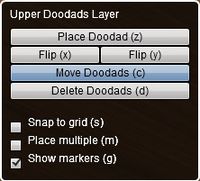 Fig. 3: Upper Doodads menu |
|
Spawn Layer Menu
- Player: None (delete spawn), Player 0 (red, you), Player 1 (blue, opponent)
- Facing: Sets orientation of the spawn unit.
- Group: "..." is "any group", often used for player's party; other numbers match group numbers in scenario editor.
- Size: use Size 1 for small (1x1) figures and Size 2 for large (2x2) figures; assigning a small figure to a large spawn point will place it on the bottom tile.
|
|
Terrain Layer Menu
- This views the terrain type of each tile and lets you override the tile's default. You have to set Difficult and Victory terrain here.
- Type: Blocked (black), Difficult (dark green), Open (light green), Victory (yellow), Impassable (blue)
- Display Opacity: set how opaque this layer is viewed
|
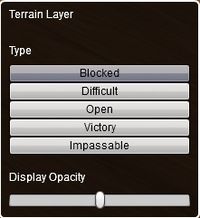 Fig. 5: Upper Doodads menu |
|
Decal Doodads Menu
- This is where you mark Difficult and Victory terrain, add non-wall Blocked terrain (like pillars and bushes), and generally make the board look pretty. Also where you add all the junk sitting on the table. Decals can be piled on top of each other.
- Place Doodad: opens decal palettes for selection
- Flip: flips the orientation of the decal
- Move Doodads: moves decal, duh !
- Delete Doodads: deletes decal, duh !
- Snap to grid: decals placed snaps to grid. Avoids overlapping decals.
- Place multiple: places multiple decals at once.
- Show markers: Not used
|
|
Tile Layer Menu
- This is where you usually start drawing your board. This is base of your map: floors, walls, water; most other stuff will be added as decals.
- Tile Palette: select a tile from a variety of palettes. Each tile has a default terrain, but you can override that in the terrain layer.
- Flip: flip the tile's orientation.
- Clear Brush: stop drawing with the current tile.
- Show Bounds: draws a blue rectangle around all the tiles you've added; useful for making sure you didn't accidentally draw some off screen.
|
|
|
Lower Doodads Menu
- Graphics you put around the edges of the board to give it thickness. Two styles to choose from, usually one of the last things you add to the board.
- Place Doodad: opens doodad palettes for selection
- Flip: flips the orientation of the doodad
- Move Doodads: moves doodad, duh !
- Delete Doodads: deletes doodad, duh !
- Snap to grid: doodad placed snaps to grid. Avoids overlapping decals.
- Place multiple: places multiple doodad at once.
- Show markers: Not used
|
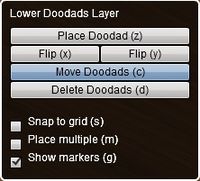 Fig. 8: Lower Doodads menu |
Table Layer Menu
- Choose the table style: wooden or MP. Note that all campaign games are played on a wooden table and all multiplayer games (including all MP and SP custom scenarios) are on green felt.
|
|
|
|
Credits


